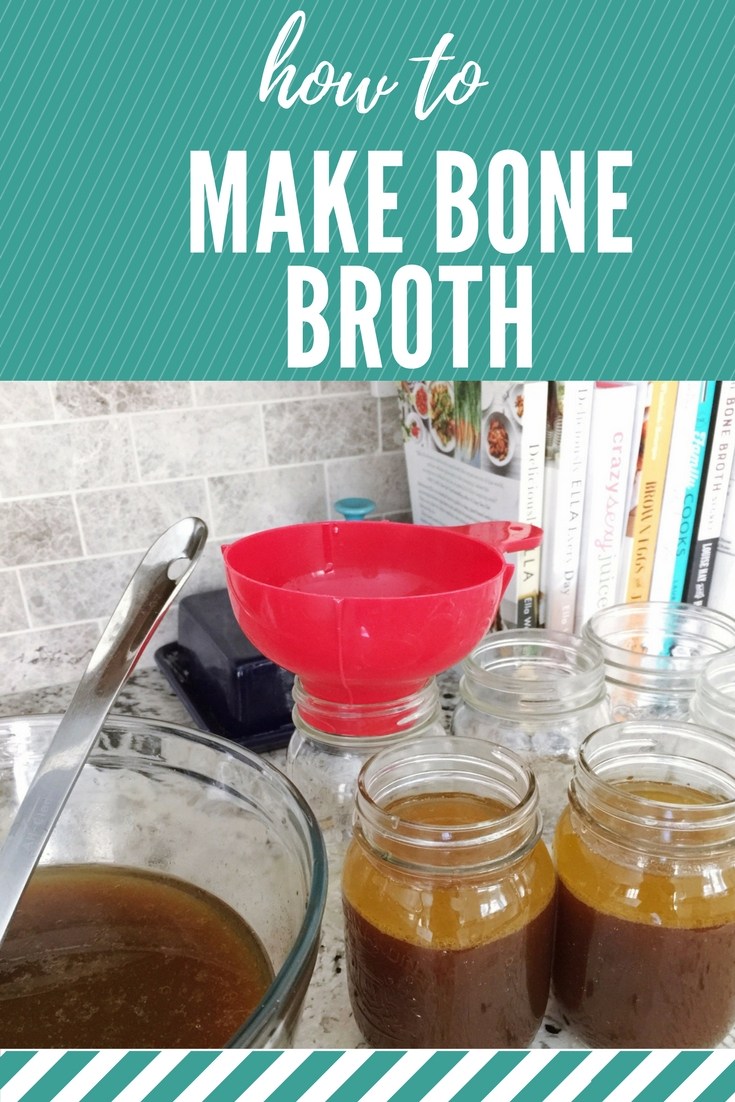It’s been nearly one year since I started drinking bone broth every morning. Today I’m telling you why I started making my own homemade bone broth in the slow cooker, and the benefits of a daily dose. It’s a question that comes up often in conversation so I thought it was time to walk you through why I added this to my morning routine.
In article after article, bone broth is being treated as the next new thing. The funny part is that it’s not new at all. Bone broth has been around nearly as long as fire. Our ancestors were so much better at using all of an animal when they hunted for food, all the way down to the bones. Bones were used as tools, and later simmered to create nourishing broths. These broths were used to treat digestive upset, and today they do the very same thing.
Last year was a tough time for our family. We moved to a new country away from all our friends and family. We had a. lot. more time on our hands, and I found myself spending it in the kitchen. Although I was lonely in a new place, I found joy in the kitchen. I dove head first into reading more nutrition books, instead of my usual slew of cookbooks. (I get new cookbooks out of the library weekly!) I registered for The Academy of Culinary Nutrition and started to make some changes to our eating habits. Making our own bone broth was a big part of the change.
It was the book, The Stash Plan, that first explained to me why bone broth was so nourishing. When we drink a rich, bone broth first thing in the morning, our body is best able to absorb all of the minerals available to us. It’s also the perfect opportunity for healing to take place in the digestive tract.
Our bodies are constantly in need of detoxifying, it’s not a yearly thing like many people believe. It’s a daily thing. Bone broth helps eliminate the waste products that builds up in the gallbladder and liver. Bone broth gives us the amino acid glycine, which helps with the production of glutathione, and helps to detox the liver. Those popular juice cleanses are missing the element of fat that is necessary for toxins to glob onto to exit the body. A homemade bone broth provides the structure needed to clear the pipes.

After a year of drinking bone broth, I feel ready to share my knowledge with you. I think it has been crucial for helping me fit strong enough to play tennis four times a week, and still have energy for the rest of the day. I drink both beef bone broth and chicken bone broth and rotate between the two. I use a slow cooker method and keep letting it cook for at least 24 hours, and then until I have 15 minutes to strain and store it. I took a break over the summer for a couple of weeks, but used a Collagen supplement in my smoothies instead. I recommend either Great Lakes or Vital Proteins brands. It was drinking bone broth that also helped me give up my coffee addiction…but that’s another long post.

WHY SHOULD WE DRINK BONE BROTH?
Bone broth is one of the best healing foods for the gut. New science is teaching us about the unique microbiome of bacteria that lives in, and on, each of us. There’s a new focus on keeping your gut microflora healthy and resilient, and bone broth is one of the best ways to do this.
BONE BROTH DOES ALL OF THE FOLLOWING:
- Heals the digestive tract
- Improves your immune system
- Provides a wide variety of rich minerals and amino acids, including calcium, iron, magnesium, potassium, zinc, and selenium.
- Anti-aging! Support skin health
- Reduces chronic inflammation
WHAT MAKES BONE BROTH SO MEDICINAL?
Both gelatin and collagen are present in bone broth. These proteins help reverse damage in your digestive tract. Our digestive tract gets damaged by using antibiotics, aspirin, Nsaids, refined sugar, flour, caffeine, alcohol, and fried food. Bone broth can also help heal leaky-gut syndrome, which affects many women with autoimmune conditions and children with Autism.
Collagen provides us with glycine, lysine, and proline. These are the amino acids that help keep our skin looking younger. Did you know the collagen in topical skin products really won’t get absorbed because the molecular structure is too large to penetrate the skin? You have to work from the inside out.
WHAT ARE WE TRYING TO AVOID IN STORE BOUGHT BROTH/STOCKS?
Many of us know we need to avoid MSG, or Monosodium Glutamate. MSG creates free glutamic acid in our body, which quickly becomes a neurotoxin. Many people often get a headache or nausea after ingesting MSG, however, there are worse side affects now documented. MSG is an excitotoxin, and it pushes our metabolism into an insulin- or adrenaline-dependent mode, which makes us store more fat. MSG is often found in processed foods or fast-food, but also in store bought stocks.
Here’s the current list of food additives or ingredients that may contain MSG (source, UnDiet):
- Autolyzed yeast
- Bouillon
- Broth
- Calcium caseinate
- Corn oil
- Flavor enhancer
- Flavoring
- Hydrolyzed oat flour
- Hydrolyzed plant protein
- Hydrolyzed protein
- Hydrolyzed vegetable protein
- Malt extract
- Natural flavors
- Plant protein extract
- Seasoning
- Sodium caseinate
- Stock
- Spices
- Textured protein (TVP)
- Yeast extract
WHY IS BONE BROTH CRUCIAL FOR CONCUSSION PATIENTS?
Bone broth helps reduce inflammation, including that in the brain, and it’s a lot harder to heal the brain if the gut is unhealthy. There’s new studies that show brain inflammation is linked to ADHD, depression, and dementia. People who switch to a diet that includes bone broth report an improvement in both mood and memory.
SHOULD I DRINK BEEF OR CHICKEN BONE BROTH?
The main difference between beef bone broth and chicken bone broth is flavor. Beef broth is better for richer stews, or for combining with roasted vegetables. Chicken broth is more mild and great for vegetable purees.
CAN I MAKE A VEGAN BROTH?
Yes, a vegan medicinal broth is possible, although it will be missing the amino acids from collagen and gelatin. If you want to upgrade your traditional vegetable broth, add seaweed. Seaweed enriches the broth with a wide variety of nutrients as well, which supports thyroid health. Get my recipe for vegan broth here.
CAN I BUY BONE BROTH FROM A STORE?
Yes, if it’s labeled as bone broth and not “stock.” I’ve heard great things about Kettle & Fire bone broth, which is available via Amazon. (Amazing, right?)
HOW DO I MAKE BONE BROTH?
There is a variety of opinion when it comes to how to make bone broth. The key factor is to make sure you have the right ratio of water to bones to make sure you get that beautiful, gelatinous consistency at the end. If you use too much water, it will cause the broth to be diluted. Also, low quality bones will also alter the broth consistency. Conventional factory farmed animal bones don’t produce as much gelatin as pasture-raised animals.
HOW LONG DOES IT TAKE TO MAKE BONE BROTH?
The longer the better! A slow cooker is a great tool to set it and forget it (mostly.) Here’s a general guideline for cooking times:
- Beef, Lamb, and Pork Broth: 12-48 hours
- Chicken and Turkey Broth: 12-48 hours
- Fish Broth: 4-24 hours
WHAT TEMPERATURE SHOULD I COOK THE BONE BROTH?
After the water is brought to a boil, reduce the heat to the lowest setting. If the heat is too high, it will destroy the collagen.
CAN I MAKE BONE BROTH IN MY INSTAPOT?
Yes, you can. However, it often doesn’t gel in the same way as traditional bone broth methods. The best way to make it is by following my recipes, but use the Soup setting on Low for 120 minutes (or longer if you have the newest versions.) Let it release the pressure naturally so you still need at least 3 hours to complete the broth. If you want to make sure you get the good gel at the end, add some chicken feet to your chicken bone broth! I have not purchased an Instapot yet, as I already have an electric pressure cooker that I love and does the same thing.
DO I NEED TO USE APPLE CIDER VINEGAR IN MY BONE BROTH?
After researching this question, my conclusion is to include either apple cider vinegar (ACV), or wine, in your broth. The acidic nature of the vinegar, or wine, helps to draw out more of the minerals from the bones. What is not suggested is to use ACV in your broth and let it sit before cooking it. In the interest of food safety, include the ACV along with your water when covering the bones to cook.
WHAT CAN I DO WITH MY BONE BROTH IF I DON’T WANT TO DRINK IT STRAIGHT?
Not everyone is keen on a mug of bone broth, but that doesn’t mean you can’t enjoy the benefits of including it in your daily routine. You can make your rice or quinoa using bone broth, use it as a base for soups, or warm it up and serve over some greens for a warm winter meal. I really enjoy the recipes for various bone broths in the Broth and Stock from the Nourished Kitchen cookbook.


Ingredients
- 4 lb. Organic meat marrow bones have butcher cut bones so marrow is exposed
- 2 large yellow onions washed and quartered, skin on if organic
- 3 carrots roughly chopped, ends removed
- 2 celery ribs roughly chopped, woody stem removed, leaves can go in
- 4 cloves of garlic smashed
- 1 ” fresh ginger root roughly chopped
- 2 tablespoons black peppercorns
- 2 bay leaves
- 4 sprigs of thyme
- 6 quarts of filtered water 24 cups (Cover the bones/vegetables)
- 2 cups mushrooms optional
- ½ cup red wine
Instructions
- Preheat oven to 375°.
- Place bones on a roasting pan in a single layer. Roast for 45 minutes.
- Transfer bones to a heavy stock pot, or slow cooker.
- Add the onions, carrots, celery, garlic, ginger, peppercorns, bay leaves, and thyme. Cover everything with water and wine.
- Bring the liquid to a boil. Skim off any foam or impurities that rise to the top. Turn heat down to the lowest setting while maintaining a simmer for at least 12 hours, and up to 48.
- Add additional water if necessary to keep bones submerged.
- Strain broth into a large bowl through a fine mesh sieve. Discard the solids.
- Transfer broth into glass jars. Store in the refrigerator for up to one week, or in the freezer for up to 6 months. Leave at least 1” of space at the top of a glass jar if you plan to freeze it. The broth will expand.

Click here to get my Homemade Chicken Bone Broth recipe.Click here to get my Vegan Broth Recipe.





